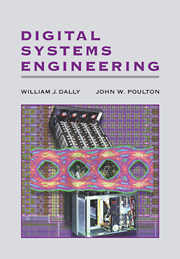Book contents
- Frontmatter
- Contents
- Preface
- Acknowledgment
- 1 INTRODUCTION TO DIGITAL SYSTEMS ENGINEERING
- 2 PACKAGING OF DIGITAL SYSTEMS
- 3 MODELING AND ANALYSIS OF WIRES
- 4 CIRCUITS
- 5 POWER DISTRIBUTION
- 6 NOISE IN DIGITAL SYSTEMS
- 7 SIGNALING CONVENTIONS
- 8 ADVANCED SIGNALING TECHNIQUES
- 9 TIMING CONVENTIONS
- 10 SYNCHRONIZATION
- 11 SIGNALING CIRCUITS
- 12 TIMING CIRCUITS
- REFERENCES
- Index
1 - INTRODUCTION TO DIGITAL SYSTEMS ENGINEERING
Published online by Cambridge University Press: 05 June 2012
- Frontmatter
- Contents
- Preface
- Acknowledgment
- 1 INTRODUCTION TO DIGITAL SYSTEMS ENGINEERING
- 2 PACKAGING OF DIGITAL SYSTEMS
- 3 MODELING AND ANALYSIS OF WIRES
- 4 CIRCUITS
- 5 POWER DISTRIBUTION
- 6 NOISE IN DIGITAL SYSTEMS
- 7 SIGNALING CONVENTIONS
- 8 ADVANCED SIGNALING TECHNIQUES
- 9 TIMING CONVENTIONS
- 10 SYNCHRONIZATION
- 11 SIGNALING CIRCUITS
- 12 TIMING CIRCUITS
- REFERENCES
- Index
Summary
Digital systems are pervasive in modern society. We use computers for bookkeeping, engineering, publishing, and entertainment. Digital communications systems handle our telephone calls and enable our Web browsing sessions. Other uses of digital systems are less visible. Most consumer electronics products are largely digital and becoming more so. Music today is distributed digitally on compact optical disks, and video production is rapidly becoming a digital process. A typical appliance is controlled digitally by a microcomputer. As many as ten microcomputers can be found in the average car for controlling functions ranging from the sound system to the antilock brakes.
A digital system represents information with discrete symbols (of which digits are a special case) rather than with a continuously varying quantity, as in an analog system. Most systems use just two symbols, often denoted by the binary digits (or bits) 0 and 1, to represent all information. Simple truth propositions are represented directly with a single bit, whereas strings of bits are used to represent more complex data.
In a digital system, noise below a given level can be completely rejected. Symbols are encoded into ranges of voltage or current level. If we add a small amount of voltage, VN, to the nominal voltage for the 0 symbol, V0, the resulting voltage, V0 + VN, will still be in the range for a 0 symbol and, more importantly, can be restored to the nominal level, V0. This property allows us to process information through many noisy stages of logic with no accumulation of noise.
- Type
- Chapter
- Information
- Digital Systems Engineering , pp. 1 - 24Publisher: Cambridge University PressPrint publication year: 1998
- 2
- Cited by

